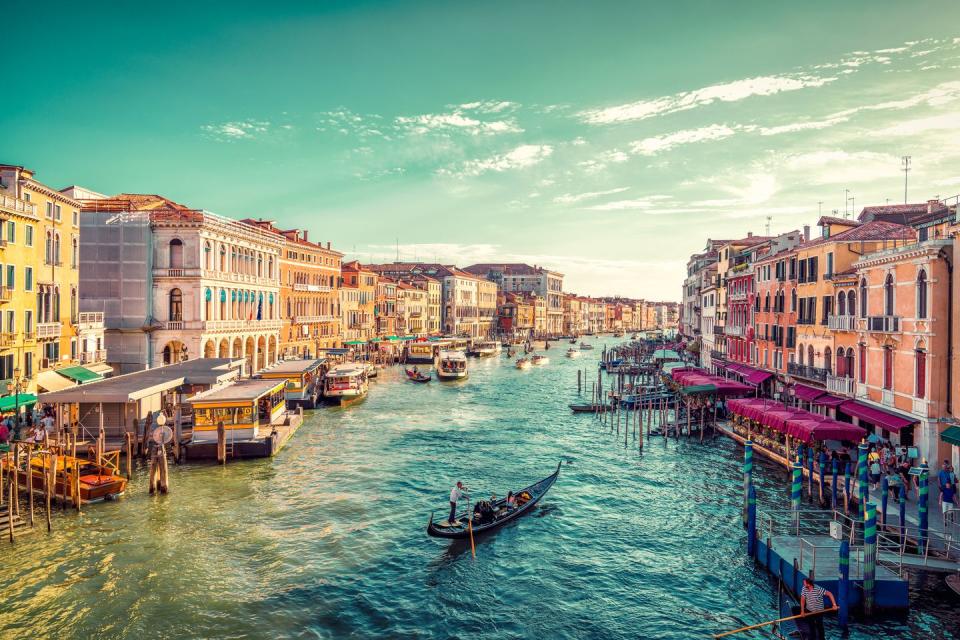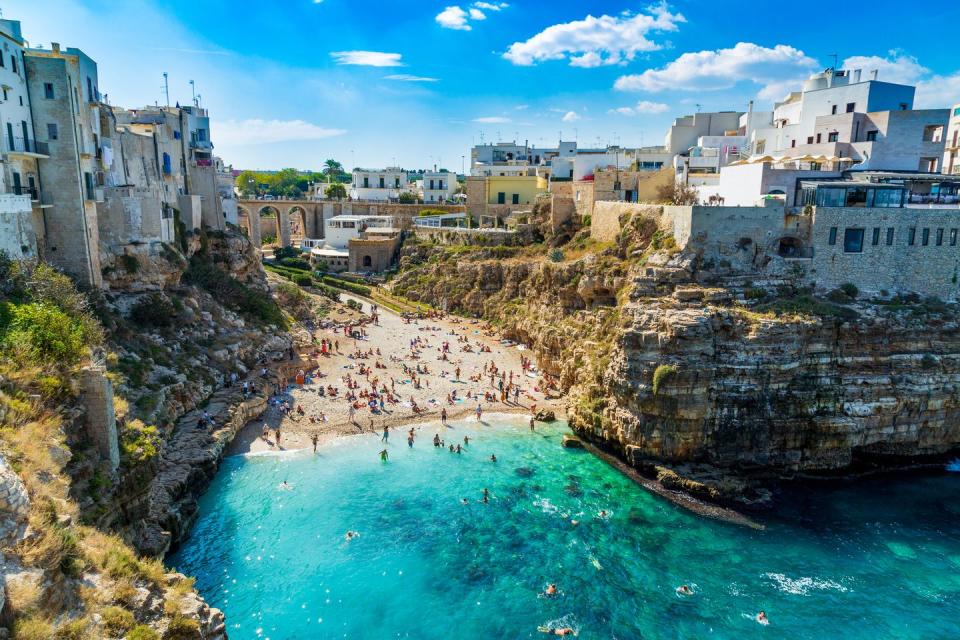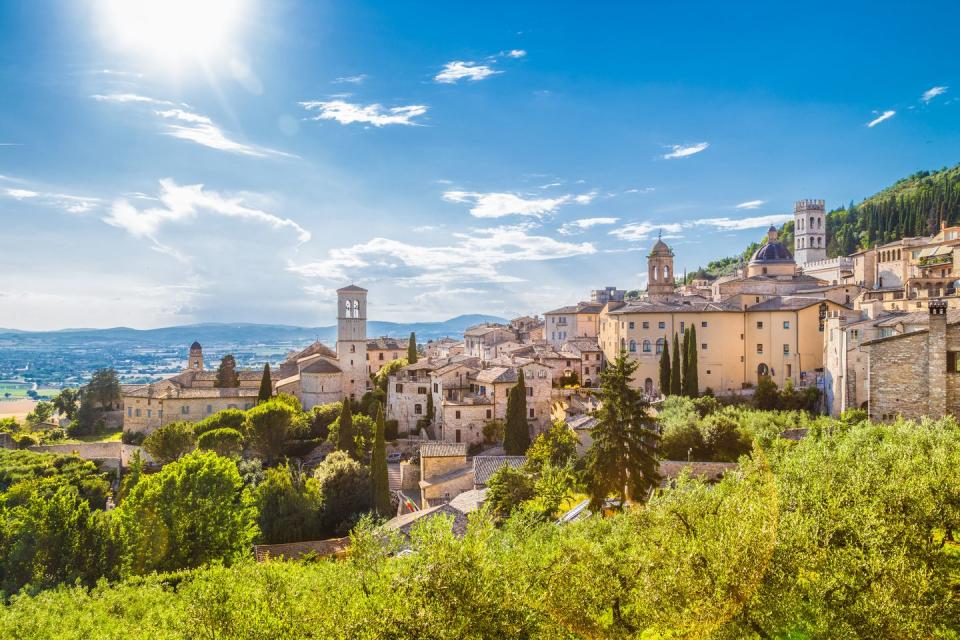The only guide you need for what and where to eat in Italy

Think of Italy, and its excellent cuisine is likely one of the first things that springs to mind. The birthplace of everything from pizza and pasta to burrata and ice cream, it’s a veritable mecca for foodies who travel from all over the world to sample the country's culinary delights in situ. For it’s in Italy itself that the famous recipes and fabulous produce really come to life – and it’s no exaggeration to say that they taste a million times better here too.
As much as Italian restaurants and cook books might have us thinking otherwise, it's important to note that there is no one unified national cuisine. Italy is in fact divided into 20 regions, each boasting its own signature dishes that are closely tied to the unique terroir, traditions and history of the area.
That’s why in Sicily you'll find so many recipes featuring aubergine, for example, that was first introduced to the island with the Arab domination of the 9th century and now grows on the land in abundance – while somewhere further north and generally cooler will hardly use it at all. It’s also why you’d never find Venice’s famous sarde in saor or Trentino’s Germanic canederli dumplings anywhere beyond their borders… And why 'real' pizza can only come from Naples, where the sea and volcanic soil of Campania produce the plump tomatoes and creamy mozzarella needed for that perfect balance of flavours (just don't bring it up with the Romans).
From much-loved classics to little-known regional recipes, there are so many delicious dishes to discover in Italy – making it the perfect place to visit for a food tour. We'd recommend eating your way around the country one region at a time, taking the time to visit local producers and farms to see what goes on behind-the-scenes, before enjoying all the delicacies in an authentic trattoria, osteria or family-run eatery nearby.
So, if you're looking to plan an Italian food tour in 2024, make sure you check out our list of the best regions for gourmands to visit in Italy – complete with tried-and-tested tips for making the most of your trip, as well as must-try dishes to tick off when you're there.
What is the foodie region of Italy?
We'd argue that every region is Italy is a certified foodie region, but if we had to just choose one to shout about, it would have to be Emilia-Romagna. Located in the north of the country, it's widely regarded as the food capital of Italy thanks to its rich gastronomic tradition and abundance of world-famous produce, including Parma ham, balsamic vinegar, Parmesan cheese, salami, tagliatelle pasta and piadina bread.
What are the must-try foods of Italy?
Each region has its own must-try foods that are specific to the location, which we've listed in our Italy food tour guide below. That said, there are some classics that you can't leave the country without sampling – and we've specified where you'll find each at its most authentic, too:
Pizza - Naples
Ice cream / gelato - Florence
Spaghetti alla Carbonara - Rome
Tiramisù - Treviso
Tagliatelle al ragù - Bologna
Arancini - Sicily
Risotto alla Milanese - Milan
Burrata - Puglia
Fiorentina steak - Tuscany
Cannoli - Sicily
Porcini and truffles - Umbria
Emilia-Romagna
Emilia-Romagna should be your first port of call if you're planning an Italian food tour. Located between Florence and Milan in the north of the country, the region is widely considered to be the food capital of Italy thanks to its rich gastronomic tradition.
Indeed, many of Italy's most important – and delicious – food products originate from here: namely, Parmigiano Reggiano (Parmesan cheese), Prosciutto di Parma (Parma ham) and Aceto Balsamico di Modena (balsamic vinegar), among others. Many of the historic dairies, farms, vineyards and artisanal botteghe (workshops) that produce these ingredients are open for tours and tastings, making it perfect for foodies who want an educational, behind-the-scenes experience.
The region's main cities, too, are hubs of culinary excellence. Modena is home to the one of the finest and most famous restaurants in the world, Massimo Bottura's iconic three-Michelin-starred Osteria Francescana, that's top of any die-hard foodie's bucket list (you'll just need to book well in advance). Parma is also a must, for obvious reasons, while Bologna is the place to go for pasta dishes such as tagliatelle al ragù, lasagne and tortellini in brodo, as well as tigelle bread pockets filled with local cured meats and cheeses.
We'd also recommend venturing a little off the beaten track to visit the likes of Ravenna, Ferrara, Piacenza and Cesena for equally fabulous food in a quieter, more authentic setting.
Alternatively, you can leave all the hard work to the experts and simply book onto Good Housekeeping's gastronomic tour of Emilia-Romagna. It includes everything from exclusive factory visits and cooking lessons, to museum visits, overnight stays in stylish hotels, and, of course, plenty of eating.

Veneto
Home to cultural heavyweights Verona, Padua, Lake Garda, Vicenza and, of course, Venice, the Veneto region has tended to be overlooked by those planning an Italian food tour – and wrongly so. For aside from boasting impressive art collections, elegant architecture and epic carnivals, Veneto also has a strong culinary identity that is well worth discovering.
First of all, it's the region responsible for such sweet masterpieces as the Tiramisù and Pandoro – the former invented in Treviso and the latter in Verona – as well as Prosecco and Aperol too. Speaking of which, Veneto has also perfected the art of the aperitivo, made all the better by the addition of cicchetti. Akin to tapas, these little finger-food snacks are served in local taverns and wine bars, and have become an art form in themselves. The most traditional bites to try are baccalà mantecato (salted cod balls), sarde in saor (sweet-and-sour sardines), crostini with savoury toppings, and fried croquettes filled with meat, tuna, cheese or potato.
With its large stretch of Adriatic coastline and city that's literally built on the water, it should come as no surprise that seafood dishes are excellent in the region – but there's also much to be said for Treviso's famous radicchio, Asiago's cheese, Bassano's white asparagus, Padua's meat stew as well as the polenta and rice that are a staple of the local diet.
If you're interested in discovering Veneto's foodie side, why not join Good Housekeeping's eight-day cruise around the region with celebrity chef James Martin? Not only will you have the opportunity to enjoy his food during an on-board gala dinner, but you'll also try local delicacies, head out on excursions and have VIP access to iconic monuments.
You can also explore the fine wines of the Veneto region on a 'Path of Prosecco' tour, which is a self-driven trip featuring behind-the-scenes tours and tastings in prestigious wineries.

Puglia
The so-called 'heel of Italy', Puglia has become something of a holiday hotspot in recent years thanks to its unspoilt beaches, whitewashed hill towns and unique trulli. In short: plenty of things to see and do to help you work up an appetite!
You'll likely be very well acquainted with the region's olive oil already – Puglia is responsible for the majority of the 'liquid gold' that's produced in the country, making it a great spot to visit if you fancy learning more about how it's made and sampling different varieties.
Puglia is also famous for its bread – namely taralli, filled panzerotti, focaccia and friselle, that are the perfect accompaniment to an aperitif of local wine. The mozzarella, burrata and stracciatella in Puglia are second to none, so we'd recommend seeking out a dairy farm tour for a demonstration and the chance to try your hand at making it yourself, before devouring the lot at its very freshest.
The towns of Lecce, Ostuni, Otranto, Bari and Brindisi are brimming with epic restaurants to discover, too. Make sure to try the signature local dishes, such as orecchiette pasta with broccoli, spaghetti with sea urchin, fava bean puree with chicory, fried octopus sandwiches and fresh seafood cooked in myriad ways.
Good Housekeeping's culinary tour of Puglia is the perfect way to taste the region's famous flavours. Over the course of six fun-and food-filled days, you'll eat your way around the best restaurants as well as experiencing an olive oil tasting and learning to make orecchiette pasta from scratch.

Campania
Set in the shadow of the magnificent Mount Vesuvius, the southern Italian region of Campania boasts a unique terrain that produces some of the most flavoursome produce in the world. Think juicy San Marzano tomatoes, milky mozzarellas and fragrant basil – which, incidentally, combine to make the perfect UNESCO-certified Neapolitan pizza.
Naples, therefore, is an absolute must for foodies – but there's a lot more than just pizza on offer. When you're in town, make sure to also tick the following local delicacies off your list: frittatine (fried cheesy pasta bites), rum-soaked Babà cakes, pizza fritta, ricotta-filled sfogliatella pastries, pasta alla Genovese (that's not, in fact, from Genova) and, of course, a few ultra-strong Neapolitan coffees to aid digestion.
Once you've eaten your way around the city, head out of town and along the picturesque Amalfi Coast for a taste of La Dolce Vita. Here, you'll find dishes centred around the freshest seafood that's caught just a few metres from your table, as well as drinks and desserts made from the ubiquitous local lemons. Stanley Tucci disciples will also know to book a table at Lo Scoglio da Tommaso for those courgette spaghetti.

Sicily
Sicily's cuisine is undoubtedly one of the most varied and interesting in the country. An island set off the toe of Italy, its prime position in the Mediterranean Sea made it an important trading hub that throughout history has been occupied by everyone from the Arabs to the Normans – and nowhere is this more evident than in the region's eclectic gastronomy.
Here, you'll find many flavours and ingredients that are rarely seen on the mainland. The sweet and sour caponata, for example, is a direct product of North African and Spanish influences; Trapani's signature dish is centred around cous-cous; arancini are thought to come from the Levantine kibbeh, while aubergine has been a mainstay ever since it first came to the island with the Arabs in the 9th century. For an Italian food tour that's steeped in rich, multi-cultural history, you can't get better than Sicily.
Each of Sicily's areas has its own distinctive character and food, too, so you'll need to set aside a good amount of time to get a full picture of the island's culinary scene. Go to Palermo for pasta alle sarde and street food staples (arancine, panelle and sfincione are a must), Catania for cassata, pasta alla Norma and horse-meat (if you dare!), Marsala for the wine, Taormina for granita, Trapani for cous-cous and a southern take on pesto, and Siracusa for spaghetti with cuttlefish ink.
Good Housekeeping Holidays offers a solo trip to Sicily, where you can discover Noto, Syracuse, Ragusa and more, while experiencing delicious Sicilian food along the way. The tour includes a wine tasting and pairing dinner on the slopes of Etna.

Umbria
Known as the green heart of Italy, Umbria is the in-the-know foodie's go-to region for rustic, country-style cuisine without the crowds. Being far less tourist-trodden than the neighbouring Tuscany (though no less beautiful), it's managed to retain its authenticity while still moving with the times, making it the perfect place for a seriously spoiling escape.
Food is central to life in Umbria: its ultra-fertile soil lends itself perfectly to vineyards, olive groves and farmland, while prized truffles and porcini mushrooms abound in the dense woodlands. There's something particularly satisfying about sitting down to a plate of pasta that is heaped with fresh local truffle for a fraction of the price you'd pay elsewhere – in fact, we'd say that alone would be worth organising a whole food tour for.
Other signature dishes in the region include the indulgent penne alla Norcina (pasta with sausage meat, mushrooms, truffle and cream), torta al testo bread stuffed with cured meats or Umbrian sausage and bitter greens, hearty lentil stews, and porchetta (roast pork) sandwiches. As one of the few Italian regions not bordered by the sea, a meat-focused cuisine is only natural – though the Lake Trasimeno does provide plenty of freshwater fish too.
The city and province of Perugia is the main hub for restaurants – including three newly Michelin-star-awarded establishments – but we'd also recommend hopping in the car to explore the region's smaller towns and family-run eateries off the beaten track. Oh, and make sure you visit the Perugina chocolate factory while you're in town too – even if just for the free samples.

Lazio
Lazio's main city, Rome, really does have it all: good weather, fascinating history, important art, ancient ruins, iconic buildings, the Vatican... And, of course, an abundance of fabulous food. You'd be hard-pressed to find a foodie who wouldn't want to sample Italy's most famous pastas in the place they were invented: carbonara, cacio e pepe, Amatriciana and Gricia all come from Lazio, and nowhere does them better. The fact that the guanciale and pecorino used in them is made locally certainly helps, too.
But the Roman food scene offers far more than just the well-known classics. Adventurous types should make sure to sample trippa alla Romana (tripe) and ox-tail stew, while if you're after a street food-style snack, supplì and a trapizzino will do the trick: the former is a particularly delicious take on the Sicilian arancini, while the latter is a new panino-pizza hybrid that's fast becoming a local staple.
Other must-try dishes that are specific to the region include carciofi alla Giudia (alarmingly addictive deep-fried artichokes) and the decadent maritozzi – huge sweet buns bursting with whipped cream, that are perfect for dipping into your morning coffee.

Tuscany
One of Italy's most-visited regions, Tuscany is a manicured marvel of rolling landscapes, sweeping pine-tree-lined roads, vast vineyards and picturesque hilltop towns. In short, it's the rural Italian idyll – and its style of cuisine follows suit.
Tuscany specialises in a style of cuisine called 'cucina povera' that centres around simple, homegrown ingredients cooked to perfection in traditional recipes. Pappa al pomodoro, torta di ceci, panzanella and crostini are perhaps the best-known "poor" dishes, while lampredotto (offal) sandwiches are the perfect example of the deep-set zero-waste mentality – and well worth a try.
That said, Tuscany is also a haven of fine dining: there are more than 30 Michelin-starred restaurants to choose from in the area, while oenophiles will find themselves spoilt for choice with so many excellent locally-produced wines to choose from. And for when you're after something a little more low-key, don't miss the chance to feast on a gigantic Fiorentina in one of Florence's many historic steakhouses, followed by a walk along the river with a homemade gelato in hand.
You can taste your way around Tuscany during an eight-day tour, with highlights including Siena, Chianti and Volterra. The foodie trip takes you on farm tours, a cooking class, cheese tasting, wine tasting, a pasta-making demonstration and more delicious activities.
FIND OUT MORE
More Italian holiday ideas:
- The best Italian family holidays
- A guide to the Italian lakes
- The best Lake Como towns
- The most stylish hotels in Sorrento
- The best Lake Garda hotels

You Might Also Like


